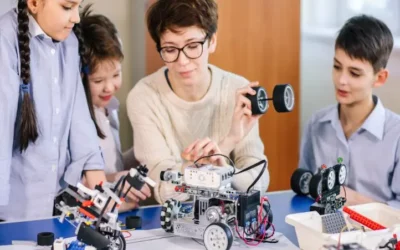Joining a Robotics Club holds immense value in the development of young minds. It provides a structured platform where children can learn essential STEM skills through hands-on experiences with robotics. Engaging in robotics education at an early age fosters problem-solving abilities, critical thinking, and creativity. The club environment not only imparts technical knowledge but also cultivates a passion for innovation, preparing young learners for the challenges of our technology-driven world.
In this blog, discover the transformative impact of joining a Robotics Club, where children not only delve into the exciting world of robotics but also cultivate essential STEM skills, fostering a foundation for problem-solving, critical thinking, and creativity in a collaborative and engaging environment.
Table of contents
Understanding Robotics
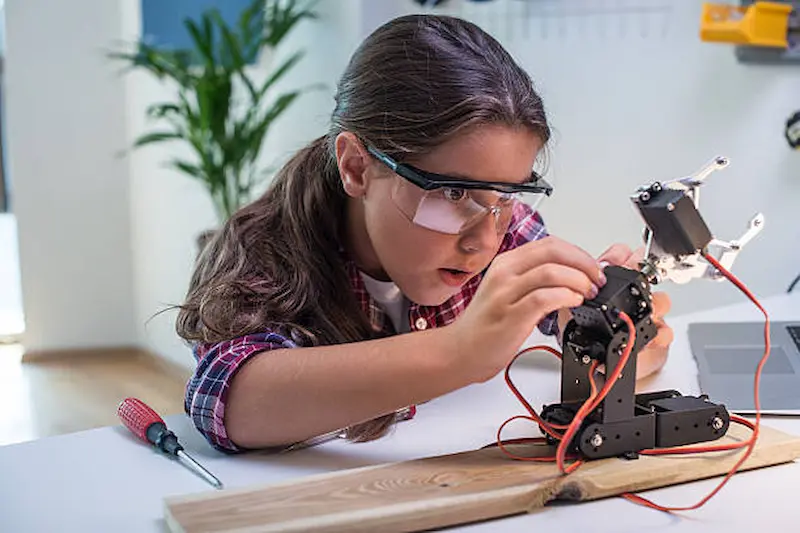
Robotics, in simple terms, is the field of designing, building, and programming machines capable of performing tasks autonomously or under human control. It encompasses a blend of mechanical, electrical, and computer engineering. Introducing robotics for kids involves providing them with hands-on experiences in creating and programming robots, offering a dynamic approach to learning the foundational principles of this multidisciplinary field.
Examples of robotics applications in everyday life
- Home Assistance and IoT Integration: Beyond mere vacuuming, robots are now seamlessly integrated with the Internet of Things (IoT), enabling them to control smart home devices, enhancing the overall convenience and efficiency of household management.
- Revolutionizing Healthcare Delivery: Robotics in healthcare extends beyond surgery. Telepresence robots facilitate remote consultations, ensuring healthcare access reaches even remote areas, while robotic exoskeletons assist patients in rehabilitation, offering a glimpse into the future of personalized care.
- Innovative Educational Tools: Beyond traditional methods, robots act as innovative educational tools, promoting STEM (Science, Technology, Engineering, and Mathematics) education. Students learn coding by programming robots, fostering a hands-on, practical understanding of complex subjects.
- Immersive Entertainment Experiences: The entertainment industry continually pushes boundaries with robots. Our kids explore the integration of virtual reality and robotics, creating immersive experiences that redefine the future of entertainment, from interactive exhibits to theme park attractions.
Precision in Industrial Automation: Delving into the heart of industrial processes, our young minds understand how robots increase precision and efficiency in manufacturing. From assembly lines to warehouse logistics, automation enhances productivity, ensuring they grasp the transformative impact of robotics on global industries.
Why Start at Ages 3-10?
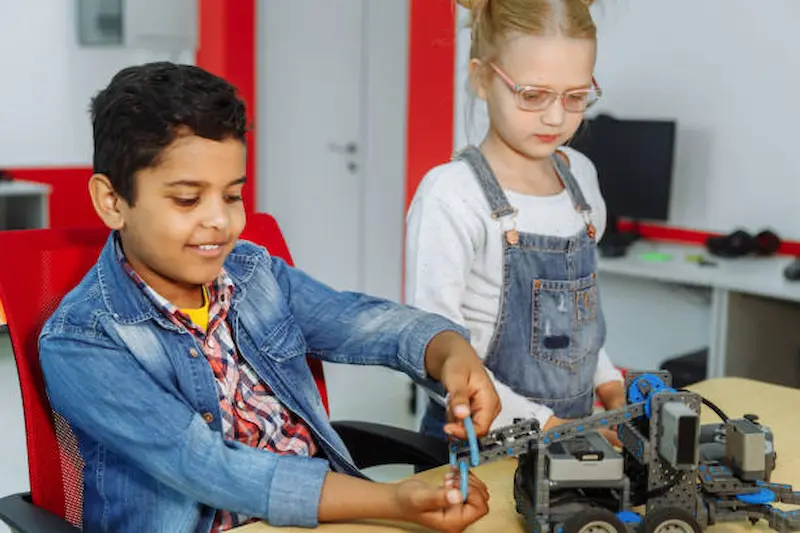
A. Cognitive development at early ages
Initiating robotics education at ages 3-10 aligns with crucial child cognitive development phases, tapping into the natural curiosity and rapid learning capacity of young minds. Exposure to robotics at these early stages lays the groundwork for a deeper understanding of technology as children grow.
B. Building a foundation for STEM skills
Starting at this age range is instrumental in building a solid foundation for STEM (Science, Technology, Engineering, and Mathematics) skills. Early engagement with robotics not only nurtures a love for exploration and problem-solving but also instills the fundamental skills essential for success in an increasingly technology-driven world.
Hands-On Learning
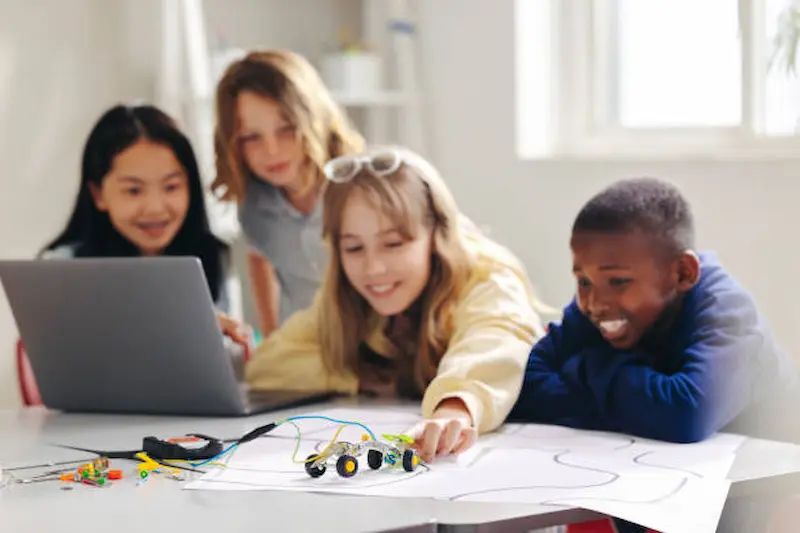
Certainly! Here’s a list of benefits of hands-on learning in a Robotics Club for Kids:
- Engagement and Interest:
- Benefit: Hands-on learning in a robotics club captures the interest and engagement of kids. By actively working on projects, kids are more likely to be enthusiastic about learning, fostering a genuine interest in robotics and technology.
- Practical Application of Concepts:
- Benefit: Kids can apply theoretical concepts in a practical setting. Hands-on activities allow children to see how theoretical concepts work in real-world applications, reinforcing their understanding and making learning more tangible.
- Problem-Solving Skills:
- Benefit: Encourages the development of critical thinking and problem-solving skills, including critical thinking skills for kids. Tackling real challenges in robotics projects requires analytical thinking, helping kids develop problem-solving skills that are applicable across various disciplines. This emphasis on critical thinking equips children with valuable tools for navigating complex problems and making informed decisions from an early age.
- Teamwork and Collaboration:
- Benefit: Promotes teamwork and collaboration among club members. Working on robotics projects encourages kids to collaborate, share ideas, and contribute to a common goal, fostering essential teamwork skills.
- Creativity and Innovation:
- Benefit: Cultivates creativity and innovation. Hands-on learning provides a platform for kids to experiment, try out new ideas, and think creatively, fostering an environment that nurtures innovation.
- Long-Term Retention:
- Benefit: Facilitates long-term retention of knowledge. Active participation in hands-on activities enhances memory retention, as children experience and interact with concepts rather than simply memorizing them.
- Real-World Application:
- Benefit: Prepares kids for real-world applications of technology. Engaging in hands-on robotics projects provides a glimpse into how technology is used in the real world, preparing kids for future educational and career opportunities.
Educational Robots
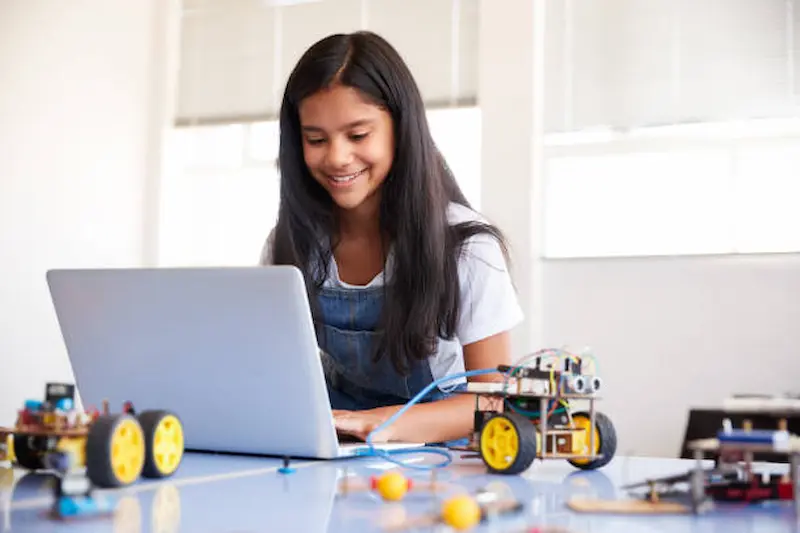
Educational robots serve as interactive companions, introducing children to fundamental concepts in a playful manner.
These robots enhance learning and engagement by combining entertainment with instruction, including robotics courses for kids. Through interactive features, these robots facilitate hands-on learning experiences, capturing children’s attention and fostering a love for exploration. This innovative approach transforms education into a dynamic and enjoyable journey, promoting a deeper understanding of key concepts in various subject areas.
Safety Measures
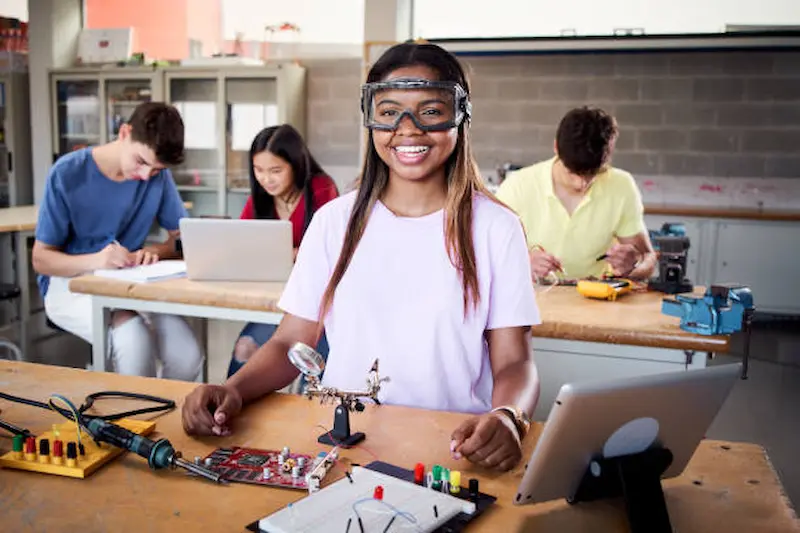
- Supervision:
- Ensure that qualified adult supervisors are present during all club activities.
- Maintain an appropriate adult-to-child ratio to enhance supervision.
- Age-Appropriate Equipment:
Use age-appropriate robotics kits and tools, ensuring they align with the skill level of the kids. These kits, designed specifically for young learners, play a crucial role in providing an engaging and educational experience. Tailoring the tools to the children’s abilities ensures that they can actively participate in hands-on activities, fostering a deeper understanding of fundamental concepts. The incorporation of robotics kits for kids not only makes the learning process accessible but also encourages a sense of accomplishment and curiosity as they navigate the challenges presented by the kits.
- Safety Training:
- Provide basic safety training to all club members before they start working on projects.
- Emphasize the importance of following safety guidelines and rules.
- Personal Protective Equipment (PPE):
- Require the use of appropriate PPE such as safety goggles and gloves when handling tools or working on projects.
- Tool Handling:
- Teach kids how to use tools properly and safely.
- Ensure that tools are age-appropriate and well-maintained.
- Workspace Organization:
- Maintain a clean and organized workspace to prevent tripping hazards.
- Clearly mark areas for different activities to avoid confusion.
- Emergency Procedures:
- Have clear emergency procedures in place, including evacuation routes and meeting points.
- Conduct regular drills to ensure that everyone is familiar with emergency protocols.
- First Aid Kit:
- Keep a well-stocked first aid kit on-site and ensure that supervisors are trained in basic first aid.
- Electrical Safety:
- Teach kids about the dangers of electrical components and how to handle them safely.
- Ensure that electrical outlets and equipment are in good condition.
- Fire Safety:
- Educate kids about fire safety protocols.
- Keep fire extinguishers in accessible locations and ensure that supervisors know how to use them.
- Allergies and Medical Conditions:
- Collect information about any allergies or medical conditions that club members may have.
- Take appropriate precautions and have necessary medications on hand.
- Behavioral Guidelines:
- Establish clear behavioral guidelines to ensure a respectful and cooperative environment.
- Discourage running or rough play in the robotics workspace.
Showcasing Creativity

Foster creative thinking in robotics projects, encouraging participants to think beyond conventional solutions. The projects become a canvas for inventive ideas, nurturing a mindset that values innovation and uniqueness.
Kids express themselves through their creations, infusing personalities into robots. This not only instills a sense of ownership but also transforms the learning experience into a platform for self-expression, where imagination and technology converge to showcase the boundless creativity of young robotics enthusiasts.
Whether through hands-on robotics kits or online robotics for kids, the opportunity for self-expression remains a central theme.
Parental Involvement
Active parental involvement is a key factor in maximizing the benefits of robotics education for kids. Parents can support their children’s learning journey by attending showcase events, engaging in discussions about robotics concepts at home, and encouraging hands-on exploration. This collaboration, rooted in parenting advice that emphasizes encouragement and open communication, fosters a positive learning environment. By actively participating in their children’s robotics education, parents not only demonstrate the value of education but also contribute to the development of essential skills such as problem-solving and creativity.
Tracking Progress

Employ effective methods, such as project assessments and robotics challenges, to track and assess children’s development in robotics. Regular evaluations provide valuable insights into individual growth, allowing for tailored guidance and skill refinement.
Create a culture of recognition by celebrating milestones and achievements. From mastering new programming skills to completing complex robotic projects, these celebrations not only boost confidence but also foster a sense of accomplishment. By acknowledging and rewarding progress, the robotics journey becomes a fulfilling and motivating experience for young learners, nurturing their passion for technology and innovation.
Making Learning Fun
Infuse excitement into the educational journey by incorporating games and play into the robotics learning process, including robotics projects for kids. Gamified elements engage young participants, transforming complex concepts into interactive challenges that enhance comprehension and retention.
Strike a harmonious balance between education and enjoyment, ensuring that each robotics activity is not only informative but also entertaining. By fostering a dynamic and fun-filled learning environment, children are motivated to explore, experiment, and embrace the world of robotics with enthusiasm, making the educational experience both enriching and enjoyable.
Overcoming Challenges
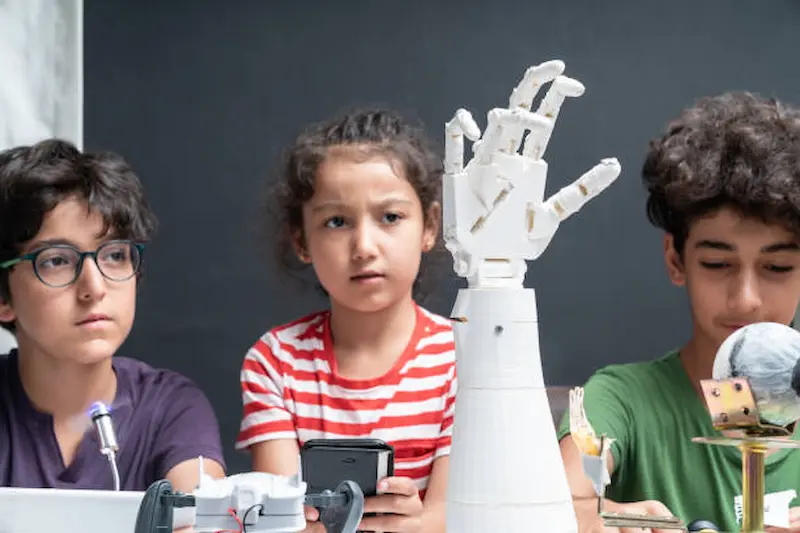
Navigate the learning journey with resilience as we address common challenges, including those encountered with the best robotics for kids. From troubleshooting technical issues to mastering complex concepts, the process of overcoming obstacles is integral to skill development. Embrace these challenges as opportunities for growth, honing problem-solving abilities and enhancing critical thinking.
In doing so, participants not only conquer hurdles in robotics but also cultivate a mindset that extends to future pursuits, fostering a resilient and adaptable approach to learning and innovation.
Conclusion
A Robotics Club for kids is a structured program that introduces children to the world of robotics through hands-on activities and collaborative projects. This engaging platform not only imparts technical skills in building and programming but also cultivates teamwork, problem-solving, and creativity. By providing a fun and educational space, Robotics Clubs empower young learners to explore the principles of robotics, setting the stage for a lifelong interest in science and technology.
To get your hands on more such articles, educational content, and free resources on coding for kids, robotics courses, game development, etc., check out the BrightCHAMPS Blog Page now!
Frequently Asked Questions ( FAQs )
A1. The Robotics Club is suitable for kids aged 8 to 14.
Q2. How often do the club sessions occur?
A2. Club sessions occur weekly, fostering consistent engagement and learning.
Q3. What is the duration of each session?
A3. Each session typically lasts for 1.5 to 2 hours, providing ample time for hands-on activities.
Q4. Are there any prerequisites for joining the club?
A4. There are no prerequisites; the club welcomes beginners and enthusiasts alike.
Q5. What kind of robotics kits do the kids use?
A5. Kids use LEGO Robotics kits, combining building blocks with technology for an interactive learning experience.
Q6. How can parents get involved in their child’s robotics journey?
A6. Parents can get involved by attending periodic showcase events, volunteering, or supporting at-home exploration of robotics concepts with their child.


 We are an army of educators and passionate learners from BrightChamps family, committed to providing free learning resources to kids, parents & students.
We are an army of educators and passionate learners from BrightChamps family, committed to providing free learning resources to kids, parents & students.









